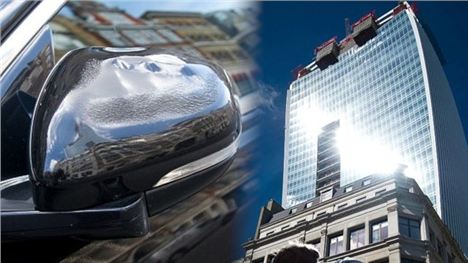THE ARCHITECTS behind London's controversial Walkie-Talkie building (20 Fenchurch Street) will design Manchester University's new £60m Graphene Engineering Innovation Centre (GEIC) at the former Faraday building site on Sackville Street.
Rafael Viñoly is also a fellow of the Royal Institute of British Architects, American Architects and Japanese Architects. The Uruguayan carries some serious credentials.
Rafael Viñoly Architects came under fire in September 2013 when 'death rays' reflected from the concave design of the new 500ft 37-storey tower (pictured) began melting cars and blistering pavement on the streets below.
Nationals soon renamed the Walkie Talkie the 'Walkie Scorchie' after a reporter from London's City A.M. newspaper managed to fry an egg in rays reportedly reaching temperatures of 90 Celsius.
Everyone got terribly excited, police suspended parking spaces while scaffolding and protective netting were erected. Eventually developers Land Securities fitted a 'brise soleil' sunshade to the building late in 2014.
What was most peculiar about the design flaw was that Rafael Viñoly Architects had dealt with this very same issue before in 2010 with their Vdara hotel in Las Vegas.
Still, let's not get bogged down in controversy, this is great news for Manchester.
Aside from melting bankers' Jaguars (comeuppance?), New York-based Uruguayan architect Rafael Viñoly is a world-renowned 'superstar architect' behind projects like New York's new 432 Park Avenue (the second tallest building in New York), Seoul's Jongno Tower and Oxford University's impressive new Mathematical Institute at the University of Oxford, as well as Manchester City's new state-of-the-art £200m academy.
Viñoly is also a fellow of the Royal Institute of British Architects, American Architects and Japanese Architects. The Uruguayan carries some serious credentials.
The new Graphene Engineering Innovation Centre (GEIC) - announced by Chancellor George Osborne in September 2014 - is due to open on the former-UMIST site in summer 2017, and has been designed to complement the National Graphene Institute (NGI), currently under construction and due to open at the University of Manchester in Spring 2015.
The GEIC will be partially funded by £15m from the UK Research Partnership Investment Fund (UKRPIF), £5m from Innovate UK and £30m from Masdar, an Abu Dhabi-based renewable energy company owned by Mubadala - an investment vehicle of the Government of Abu Dhabi.
A spokesperson for the Manchester University said: "Together, the two facilities will reinforce Manchester’s position as a globally leading knowledge base in graphene research and commercialisation."
Vice-President and Dean of the Faculty of Engineering and Physical Sciences, Professor Colin Bailey, said:
“Research and development in graphene and 2-D material applications will transform the world. The world-leading knowledge base is here in Manchester and to harvest this knowledge, for the benefit of the economy and society more widely, urgent infrastructure facilities are required.
"The GEIC, supported by part funding from the UKRPIF, TSB and Masdar, is essential to maintain the UK’s international leadership position in this area and ensure effective commercialisation of a UK discovery.”
Follow @David8Blake on twitter.
See here for more projects by Rafael Viñoly Architects.














